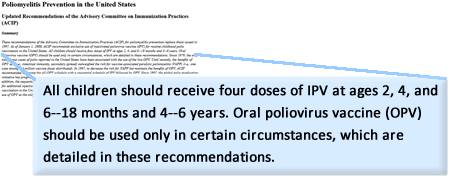Focus on What Makes Your Business Smart: From Interpretation to Implementation Step 1: Interpret from Sources
In this series, I will examine a case study and highlight important areas in capturing business concepts, business rules, and operational business decisions. I selected a case study using immunization rules for children. Almost certainly, none of your businesses is about immunization. That is a major reason I picked this case study: I would like you to see that the issues, challenges, and solutions are similar across all businesses. You will also see how this approach can help you understand and handle the complexity of problems that you might not be familiar with.
The 7 steps to capture business concepts, business rules, and operational business decisions from source to implementation are
Step 1 — Interpret from sources
Step 2 — Structure decision logic
Step 3 — Analyze and refine
Step 4 — Develop scenarios
Step 5 — Map vocabulary to data
Step 6 — Invoke tools
Step 7 — Run scenarios
As mentioned in Part 1, the main focus for business analysts is steps 1 to 4. I will demonstrate how analysis work done comprehensively up front can provide complete traceability and expedite technical activities (steps 5 to 7). Here's how you can ensure you will reap a substantial business return on your system implementation.
Step 1 — Interpret From Sources
The rules of your organization are in the form of policies and business rules or constraints that can be found in physical documentation (regulations, agreements, websites, etc.), in people's heads, and in system code. You will find that sources, no matter which form, are often imprecise, disjointed, and inconsistent.
|
The goals of this step |
|
|
Responsible parties |
|
|
Techniques and methodology |
|

Figure 1. Excerpt from the Advisory Committee on Immunization Practices.
Figure 1 shows an excerpt from the Advisory Committee on Immunization Practices, the authoritative guide for all immunization practices in North America. This small passage illustrates how a well-written source document can still be imprecise. At first reading, this passage might seem clear and easy to understand. However, in order to enable compliance and ensure the precision required for business implementation, the following questions must be answered:
- Is 'ages 2 and 4' in years or months?
- Does this passage stipulate up to, or up to and including (through), 18 months and 6 years?
- Does this passage stipulate vaccination at 2 months or at 4 months? What about +/- 1 day? ... +/- 5 days? ... +/- 30 days? What is the threshold?
One of the goals of this step is enabling business stakeholders to increase precision. This will require research and deep analysis.
In this example, we need to introduce new concepts such as the following:
- Minimum Age
- Maximum Age
- Earliest Recommended Age
- Latest Recommended Age
Business Stakeholders need to provide the business rules for each of these concepts in order to provide precision.
Using industry best practices, business analysts play a vital role in guiding business stakeholders to structure their thinking to ensure precision, consistency, and completeness.
Business stakeholders may have to do research or interpretation. Business analysts may conduct facilitated sessions or one-on-one interviews to drive out the detail and precision. In this example, our result for interpreting 'at ages 2 …' is the following:
- Absolute minimum age is 6 weeks - 4 days.
- Minimum age is 6 weeks.
- Earliest recommended age is 2 months.
- Latest recommended age is 3 months + 4 weeks.
The deliverables in this step might not be as structured as we will see in step 2; however, methods and techniques that will be used in step 2 can also be used in this step. The right method and technique will aid business analysts in asking the right questions at the right time to develop the right content. If applied correctly, the same techniques can be used to harvest business rules from documentation, people's heads, and system code.
Just Remember…
Plainly speaking, here are some of the main things you need to remember:
- Source documents are always imprecise, inconsistent, and disjointed.
- Participation from knowledge workers is required to fill in the gaps.
- Business analysts need to facilitate and use discipline and techniques that ask the right questions to guide knowledge workers through the thinking process.
# # #
About our Contributor:
Online Interactive Training Series
In response to a great many requests, Business Rule Solutions now offers at-a-distance learning options. No travel, no backlogs, no hassles. Same great instructors, but with schedules, content and pricing designed to meet the special needs of busy professionals.











How to Define Business Terms in Plain English: A Primer
How to Use DecisionSpeak™ and Question Charts (Q-Charts™)
Decision Tables - A Primer: How to Use TableSpeak™
Tabulation of Lists in RuleSpeak®: A Primer - Using "The Following" Clause
Business Agility Manifesto
Business Rules Manifesto
Business Motivation Model
Decision Vocabulary
[Download]
[Download]
Semantics of Business Vocabulary and Business Rules